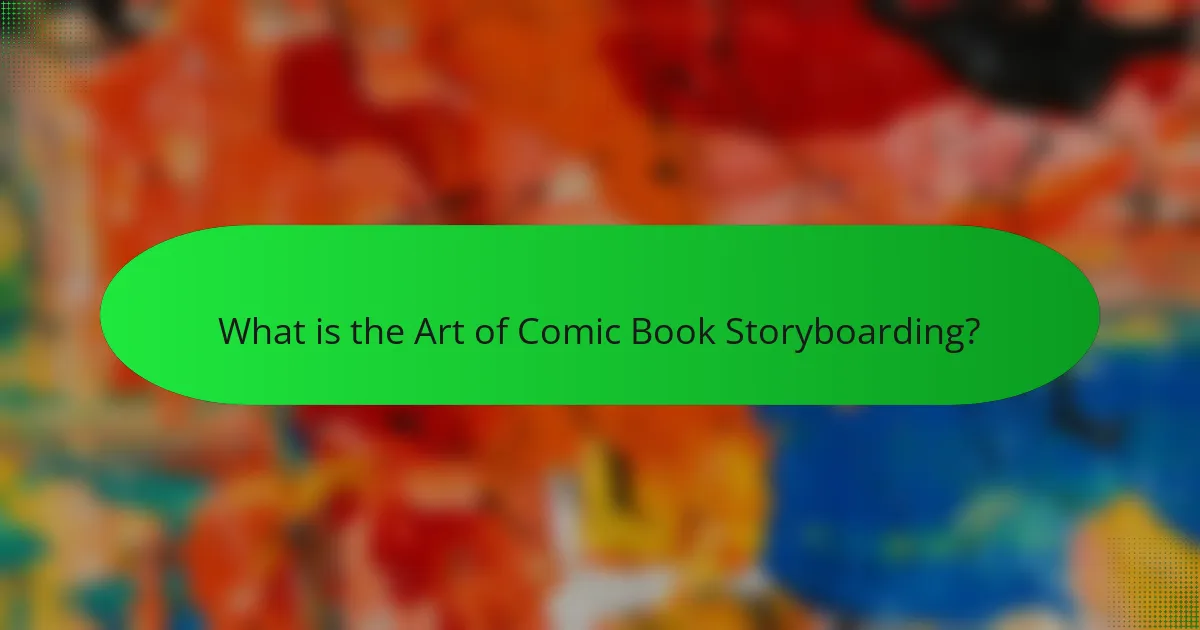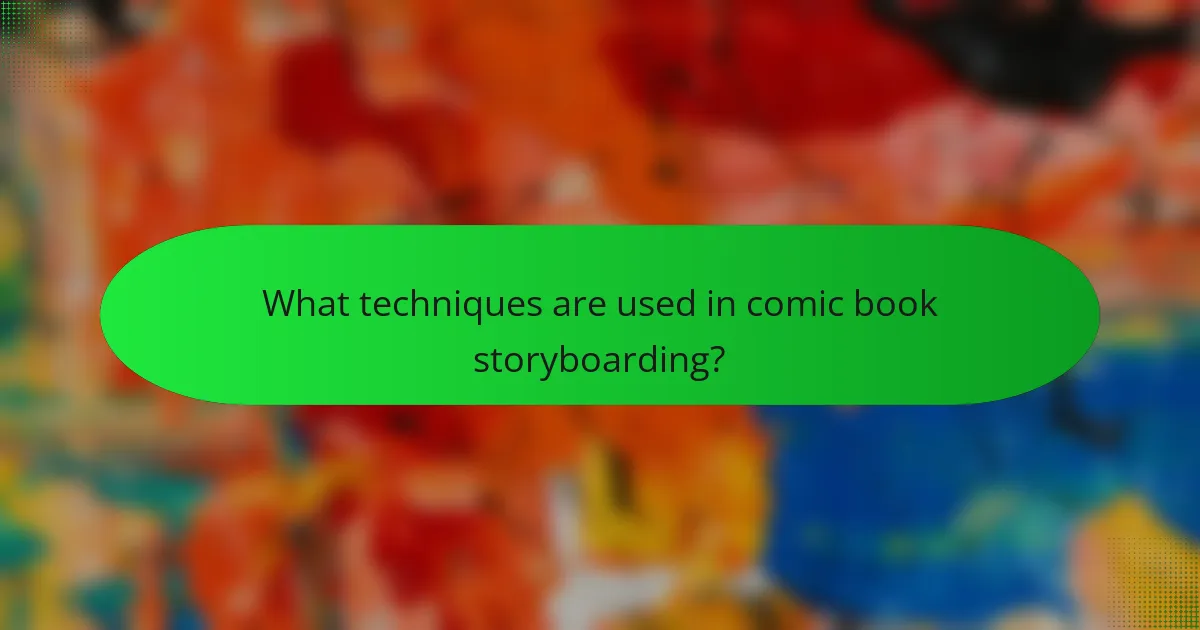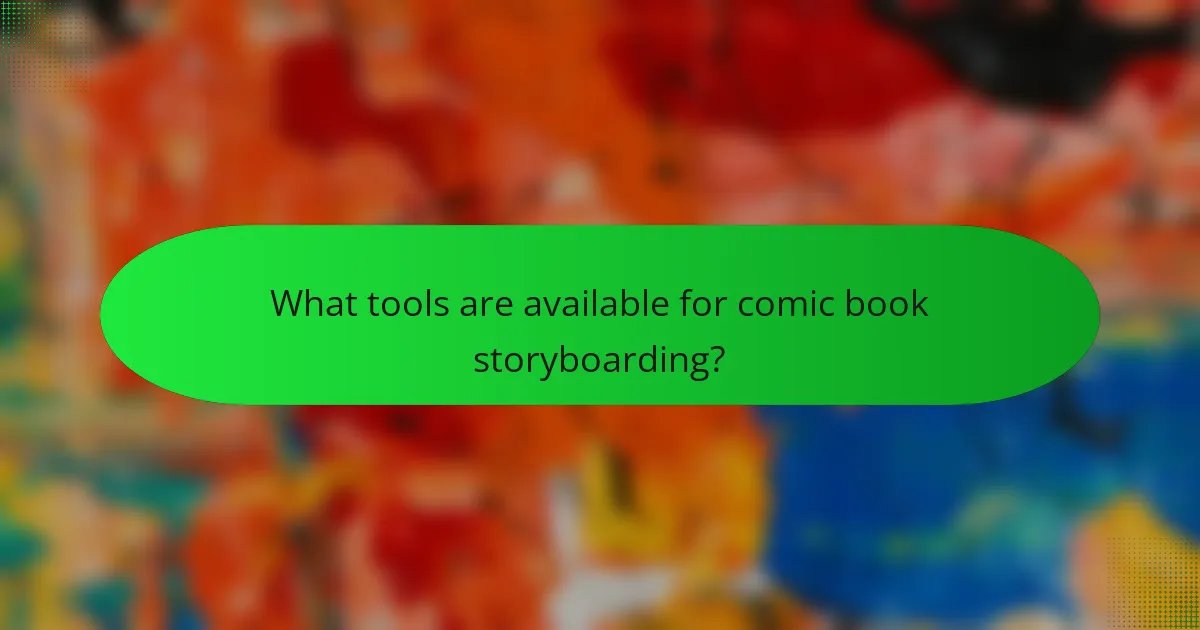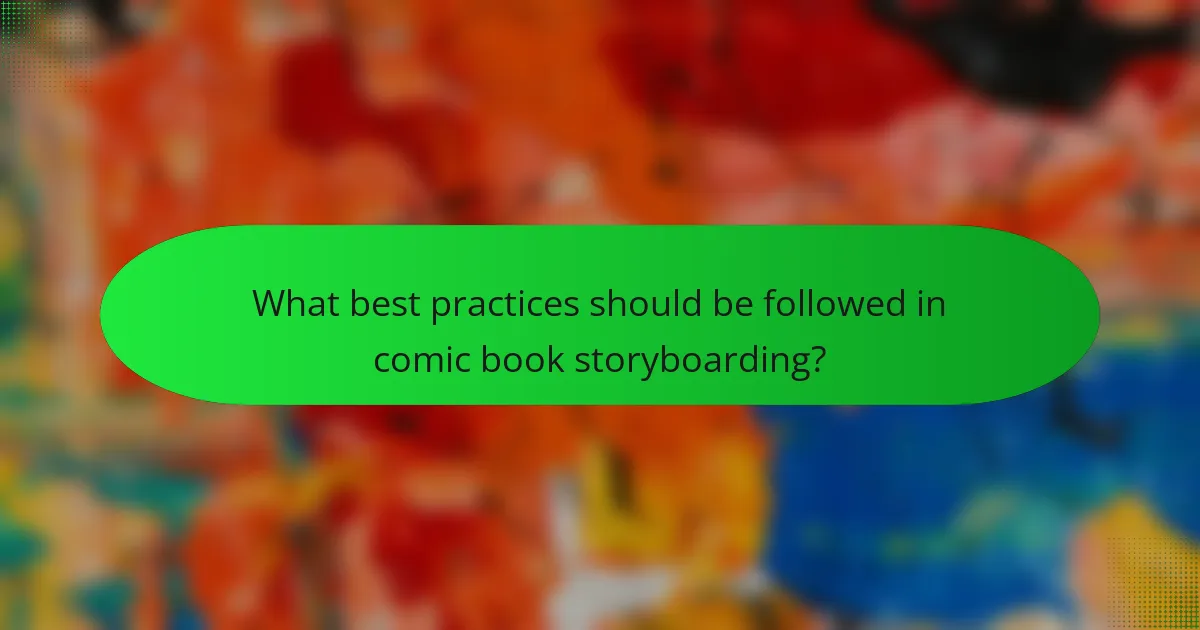Comic book storyboarding is a crucial process that involves planning and visualizing the narrative flow of a comic. It serves as a blueprint for the comic’s layout, helping artists organize scenes, characters, and dialogue effectively. Key techniques include thumbnail sketches for composition, panel layouts for image and text arrangement, and visual pacing to control the story’s flow. Various digital tools, such as Clip Studio Paint and Storyboard Pro, facilitate this process, while best practices emphasize the importance of strong scripts, character consistency, and revision for clarity. Notable comic creators have highlighted storyboarding as foundational to producing engaging and well-structured comics.

What is the Art of Comic Book Storyboarding?
The art of comic book storyboarding involves planning and visualizing the narrative flow of a comic. It serves as a blueprint for the comic’s layout and pacing. Storyboarding helps artists organize scenes, characters, and dialogue effectively. This process includes sketching panels, determining angles, and establishing visual storytelling techniques.
Comic book storyboarding enhances clarity and coherence in the narrative. It allows creators to experiment with composition and pacing before finalizing artwork. Many professional comic artists utilize storyboards to streamline their creative process. The practice has historical roots in early comic strips and animation.
Notable comic creators, such as Will Eisner, have emphasized the importance of storyboarding in visual storytelling. This technique is foundational in producing engaging and well-structured comics.
How does storyboarding enhance comic book creation?
Storyboarding enhances comic book creation by providing a visual framework for storytelling. It allows creators to plan the sequence of events and pacing effectively. Each panel can be sketched to visualize dialogue and action. This process helps identify narrative flow and transitions. Storyboards also facilitate collaboration among writers, artists, and editors. They serve as a reference point during the illustration phase. Studies show that storyboarding can improve clarity and coherence in visual narratives. This structured approach minimizes revisions and streamlines production.
What are the key elements of effective comic book storyboarding?
Effective comic book storyboarding includes several key elements. These elements are crucial for visual storytelling. First, a clear narrative structure is essential. This structure guides the flow of the story. Next, character development must be evident in the storyboard. Characters should have distinct traits and arcs. Additionally, pacing is vital for maintaining reader engagement. Proper pacing controls the rhythm of the story. Visual composition also plays a significant role. This includes framing, angles, and shot selection. Finally, dialogue placement must enhance the visuals. Well-placed dialogue supports the narrative without overwhelming the artwork. Each of these elements contributes to a cohesive and engaging comic book experience.
How does storyboarding influence narrative flow in comics?
Storyboarding significantly influences narrative flow in comics by providing a visual roadmap for storytelling. It helps in organizing scenes and determining pacing. Each storyboard panel represents a moment in the narrative, guiding the reader through the plot. This structure ensures that transitions between scenes are smooth and logical. Storyboarding allows creators to visualize character interactions and emotional beats. It also aids in balancing dialogue and action, which is crucial for maintaining reader engagement. By laying out the sequence of events, storyboarding prevents narrative confusion and enhances coherence. Ultimately, effective storyboarding is essential for creating a compelling and fluid comic narrative.
Why is storyboarding important for comic book artists?
Storyboarding is crucial for comic book artists as it serves as a visual blueprint for the narrative. It allows artists to plan the sequence of events and pacing effectively. This process helps in organizing the story’s flow and ensuring coherence. Storyboards enable artists to visualize character actions and dialogue placement. They also assist in determining panel layouts and transitions between scenes. A well-structured storyboard can enhance storytelling by highlighting key moments and emotional beats. Moreover, it facilitates collaboration between writers and artists, ensuring a unified vision. Overall, storyboarding is an essential step in the comic book creation process that improves both efficiency and creativity.
What role does storyboarding play in visual storytelling?
Storyboarding is a critical tool in visual storytelling. It serves as a visual blueprint for narratives. This technique allows creators to plan sequences effectively. Each frame represents key moments in the story. Storyboarding helps in organizing thoughts and maintaining narrative flow. It also aids in visualizing camera angles and character movements. This process enhances communication among team members. Research shows that storyboarding can improve storytelling efficiency by up to 30%.
How can storyboarding improve communication among creative teams?
Storyboarding improves communication among creative teams by providing a visual representation of ideas. This visual format allows team members to understand concepts quickly. It helps in aligning everyone’s vision for the project. Storyboards serve as a reference point during discussions. They clarify roles and responsibilities within the team. Additionally, they facilitate feedback and revisions in a structured manner. Research shows that visual aids enhance retention and comprehension. A study by the University of Minnesota found that visual information is processed 60,000 times faster than text. This efficiency leads to more effective collaboration and decision-making.

What techniques are used in comic book storyboarding?
Comic book storyboarding utilizes techniques such as thumbnail sketches, panel layouts, and visual pacing. Thumbnail sketches help artists plan the overall composition quickly. Panel layouts define the arrangement of images and text on a page. Visual pacing controls the flow of the story through the timing of panels. Artists often employ dynamic angles to create excitement. They also use dialogue placement to enhance storytelling. Additionally, storyboarding may include character expressions to convey emotions. These techniques are essential for effective visual storytelling in comics.
How can artists develop their storyboarding skills?
Artists can develop their storyboarding skills through practice and study. Regularly creating storyboards helps improve visual storytelling. Analyzing existing storyboards from films and comics enhances understanding of composition and pacing. Participating in workshops or online courses provides structured learning and feedback. Collaborating with other artists fosters new perspectives and techniques. Utilizing software tools like Storyboard Pro or Adobe Photoshop streamlines the process. Studying the principles of cinematography informs better framing and shot selection. Engaging in critique sessions helps identify strengths and areas for improvement.
What exercises can improve storyboarding techniques?
Practicing thumbnail sketches can improve storyboarding techniques. Thumbnail sketches are small, quick drawings that capture the essence of scenes. They help artists focus on composition and pacing. Storyboard artists can also benefit from creating character turnarounds. Character turnarounds provide a consistent view of characters from multiple angles. This aids in maintaining visual continuity throughout the storyboard. Another effective exercise is to analyze existing storyboards from films or comics. Studying these examples reveals how professionals convey story and emotion. Additionally, participating in timed drawing challenges enhances speed and efficiency. These exercises collectively build a storyboard artist’s skills and confidence.
How does practicing perspective and composition enhance storyboarding?
Practicing perspective and composition enhances storyboarding by improving visual storytelling skills. Mastering perspective allows artists to create depth and spatial relationships in scenes. This technique helps convey realistic environments and character placements. Composition principles guide the arrangement of elements within a frame. Effective composition directs viewer attention and enhances narrative flow. Research shows that strong visual composition can increase audience engagement by up to 70%. Therefore, these practices are essential for impactful storyboarding in comic book art.
What are common storyboarding styles in comic books?
Common storyboarding styles in comic books include grid layouts, full-page spreads, and dynamic panel arrangements. Grid layouts feature a consistent arrangement of panels, providing a structured flow. Full-page spreads allow for expansive visuals and dramatic storytelling moments. Dynamic panel arrangements use varying panel sizes and shapes to enhance action and pacing. These styles cater to different narrative needs and artistic expressions. For example, grid layouts are often used in superhero comics for clarity. In contrast, full-page spreads are popular in graphic novels for impactful scenes.
How do different styles affect the storytelling process?
Different styles significantly influence the storytelling process in comic book storyboarding. Each style can alter the tone, pacing, and emotional impact of the narrative. For instance, a minimalist style may focus on essential elements, enhancing clarity and directness. Conversely, a detailed and intricate style can create a rich visual experience, drawing readers deeper into the storyline.
Additionally, styles can affect character expression and dialogue presentation, shaping how audiences perceive characters’ emotions and motivations. Research indicates that visual styles can evoke different emotional responses from readers, impacting their engagement with the story. Studies show that comics with varied artistic styles can lead to diverse interpretations of the same narrative, highlighting the importance of style in storytelling.
What are the benefits of using a grid system in storyboarding?
Using a grid system in storyboarding enhances organization and clarity. It allows creators to structure scenes effectively. A grid helps in maintaining consistent proportions and layouts across panels. This consistency aids in visual storytelling by guiding the viewer’s eye. Additionally, grids facilitate the alignment of characters and backgrounds. They can also improve pacing by controlling the flow of visual information. Studies show that a structured approach can lead to more cohesive narratives. Overall, employing a grid system streamlines the storyboarding process and improves the final output.

What tools are available for comic book storyboarding?
Digital tools for comic book storyboarding include software like Clip Studio Paint, Storyboard Pro, and Adobe Photoshop. Clip Studio Paint offers features tailored for comics, including panel layouts and vector tools. Storyboard Pro is designed specifically for storyboard artists, providing animation integration and timeline features. Adobe Photoshop is versatile, allowing for detailed artwork and layering. Other tools include traditional options like sketchbooks and pencils for hand-drawn storyboarding. Each tool caters to different preferences and styles in the comic creation process.
What digital tools can assist in comic book storyboarding?
Digital tools that assist in comic book storyboarding include software like Clip Studio Paint, Storyboard Pro, and Adobe Photoshop. Clip Studio Paint offers specialized features for comic artists, such as panel layouts and vector tools. Storyboard Pro is designed for film and animation storyboarding, providing a comprehensive set of tools for visual storytelling. Adobe Photoshop is widely used for its versatility in digital art creation, including comic book layouts. These tools streamline the process of creating visual narratives and enhance creativity.
How do software programs compare in terms of storyboarding features?
Software programs vary significantly in their storyboarding features. Some programs offer advanced drawing tools, while others focus on text-based outlines. Programs like Storyboard Pro provide extensive features for animatics and timing, which are beneficial for animation projects. In contrast, tools like Canva offer simpler drag-and-drop interfaces suitable for quick storyboarding. Additionally, software such as Celtx integrates scriptwriting with storyboarding, enhancing workflow for filmmakers. Each program’s features cater to different user needs, whether for detailed illustrations or straightforward planning.
What are the advantages of using traditional tools for storyboarding?
Traditional tools for storyboarding offer several advantages. They provide a tactile experience that enhances creativity. Artists can easily sketch ideas without digital distractions. Physical materials allow for spontaneous changes and quick iterations. Traditional tools also foster a deeper connection to the artwork. This connection can lead to more authentic storytelling. Moreover, using paper and pencil can be less intimidating for beginners. It encourages experimentation without the fear of technology. Studies show that hands-on methods can improve retention and understanding of visual narratives.
What resources are helpful for aspiring storyboard artists?
Books on storyboarding are essential resources for aspiring storyboard artists. “The Storyboard Artist: A Guide to Freelancing in Film, TV, and Advertising” by Giuseppe Cristiano provides practical insights. Online courses from platforms like Skillshare and MasterClass offer structured learning. Websites such as storyboardart.org provide tutorials and community support. Software like Toon Boom Storyboard Pro and Adobe Photoshop are industry standards for creating storyboards. Networking through forums and social media can connect artists with professionals. Attending workshops and industry conventions also enhances learning opportunities.
Which books and online courses provide valuable insights into storyboarding?
Books such as “Storyboarding Essentials” by David Harland Rousseau and Benjamin Reid Phillips offer valuable insights into storyboarding. This book provides a comprehensive guide on techniques and best practices. Another notable book is “Framed Ink” by Marcos Mateu-Mestre, which focuses on visual storytelling and composition. Online courses like “Storyboarding for Animation” on platforms like Udemy present structured lessons on the subject. Additionally, the “Storyboarding Fundamentals” course on Skillshare teaches essential skills for effective storyboarding. These resources collectively enhance understanding and skills in storyboard creation.
How can mentorship and workshops enhance storyboarding skills?
Mentorship and workshops enhance storyboarding skills by providing structured guidance and practical experience. Mentorship offers personalized feedback from experienced professionals. This feedback helps individuals identify their strengths and areas for improvement. Workshops facilitate hands-on learning and collaboration with peers. Participants can practice techniques and receive immediate critiques. Studies show that collaborative environments improve skill acquisition and retention. According to research by the National Endowment for the Arts, mentorship can significantly boost creative development. Overall, these opportunities foster a deeper understanding of storyboarding principles and techniques.

What best practices should be followed in comic book storyboarding?
Effective comic book storyboarding requires clear visual storytelling. Start with a strong script that outlines the narrative. Break the script into panels to visualize pacing and flow. Use thumbnails to sketch layouts quickly. Focus on character expressions and actions to convey emotions. Maintain consistency in character design and settings throughout the storyboard. Incorporate dialogue and captions to enhance the narrative. Review and revise the storyboard to improve clarity and impact. These practices ensure a cohesive and engaging comic book narrative.
How can artists create effective storyboards?
Artists can create effective storyboards by following a structured approach. First, they should define the narrative clearly. This involves outlining the key scenes and actions. Next, artists can sketch thumbnails for each scene. Thumbnails help visualize the sequence and pacing. Additionally, incorporating character expressions and movements enhances storytelling. Artists should also consider camera angles and framing in their sketches. This adds depth and perspective to the storyboard. Finally, reviewing and revising the storyboard ensures clarity and coherence. Effective storyboards serve as a roadmap for the final piece.
What are the key steps in the storyboarding process?
The key steps in the storyboarding process include defining the narrative, creating a shot list, sketching scenes, adding dialogue and notes, and reviewing the storyboard. First, defining the narrative sets the overall direction and plot. Next, creating a shot list organizes the visual elements needed for each scene. Sketching scenes visually represents the action, characters, and settings. Adding dialogue and notes provides context and details for each frame. Finally, reviewing the storyboard allows for adjustments and improvements before finalizing the project. Each step is crucial for effective storytelling in comic book creation.
How can feedback be incorporated into storyboarding for improvement?
Feedback can be incorporated into storyboarding by systematically reviewing and integrating suggestions from peers and stakeholders. This process begins with gathering input at various stages of storyboard development. Regular feedback sessions can identify areas for clarity, pacing, and character development. Incorporating specific critiques can enhance the visual narrative and emotional impact. Utilizing tools like collaborative software can streamline the feedback process. Documenting feedback allows for tracking changes and improvements over time. Studies show that iterative feedback improves creative outcomes by fostering collaboration and diverse perspectives. The research by Scott et al. (2020) in the Journal of Creative Behavior supports the effectiveness of feedback in enhancing creative projects.
What common mistakes should be avoided in storyboarding?
Common mistakes to avoid in storyboarding include neglecting to plan the narrative structure. A well-defined structure helps maintain coherence. Failing to consider pacing can lead to rushed or drawn-out scenes. Overcomplicating visuals may distract from the story. Inconsistent character designs can confuse the audience. Not utilizing thumbnails can hinder the flow of ideas. Ignoring feedback from peers limits improvement opportunities. Lastly, overlooking the importance of transitions can disrupt the viewer’s experience. Each of these mistakes can significantly impact the effectiveness of the storyboard.
How can artists identify and rectify storyboard flaws?
Artists can identify storyboard flaws by reviewing the narrative flow and visual coherence. They should analyze each panel for clarity and pacing. Comparing storyboards to the script helps ensure alignment with the intended message. Gathering feedback from peers can reveal overlooked issues. Artists can also utilize checklists to assess elements like character consistency and scene transitions. Rectifying flaws involves revising panels for better composition and clarity. Artists may redraw scenes or adjust dialogue placement as needed. Iterative revisions often lead to improved storyboards. This process enhances overall storytelling effectiveness.
What strategies can help maintain consistency in storyboards?
Establishing a clear style guide is crucial for maintaining consistency in storyboards. A style guide outlines visual elements, character designs, and color palettes. This ensures all storyboard frames align with the intended artistic vision. Regular reviews of completed panels help identify inconsistencies early. Feedback from team members can also enhance cohesion. Using templates for layouts streamlines the process and ensures uniformity. Additionally, maintaining a storyboard log can track changes and decisions throughout the project. These strategies collectively support a consistent narrative flow and visual integrity in storyboarding.
What tips can enhance your comic book storyboarding experience?
To enhance your comic book storyboarding experience, focus on planning and visualization. Start with a clear outline of your story. This helps in organizing the narrative structure. Use thumbnails to sketch out scenes quickly. This method allows for faster adjustments. Experiment with panel layouts to find the most dynamic compositions. Varying panel sizes can create visual interest. Incorporate character expressions and actions in your sketches. This adds depth to the storytelling. Review and revise your storyboards regularly. Iteration leads to improved clarity and flow. Lastly, seek feedback from peers or mentors. Constructive criticism can provide new perspectives.
The main entity of this article is comic book storyboarding, which encompasses the techniques, tools, and best practices used to visually plan and organize comic narratives. The article outlines the significance of storyboarding in enhancing narrative flow, character development, and visual coherence in comics. Key elements discussed include effective storyboarding techniques, the role of digital and traditional tools, and strategies for improving communication among creative teams. Additionally, the article highlights common mistakes to avoid and provides actionable tips for artists to enhance their storyboarding skills.